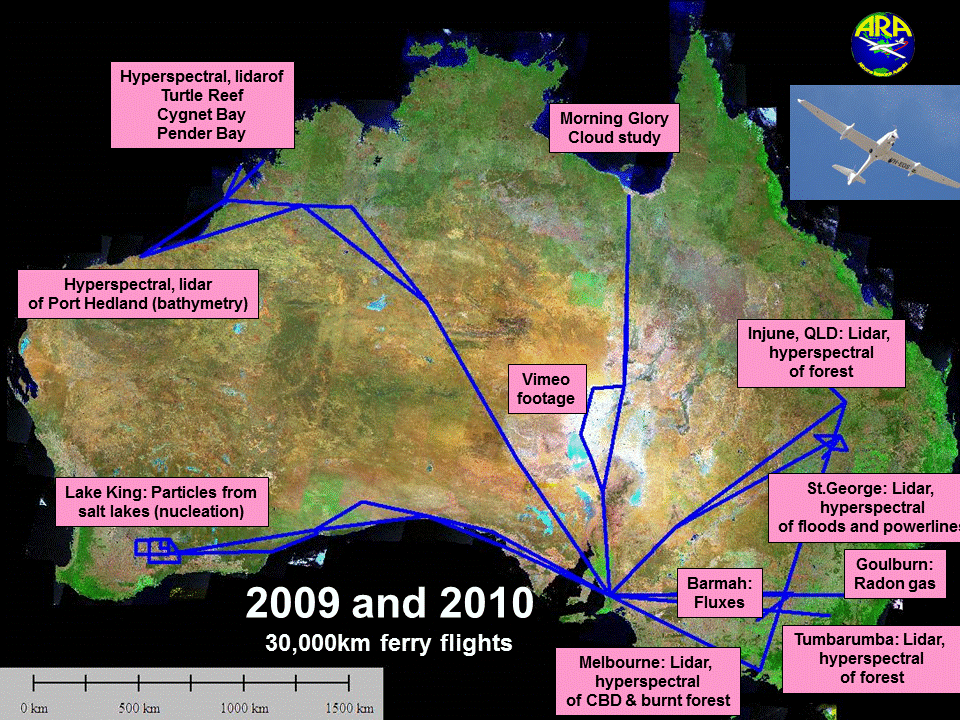AIRBORNE PLATFORMS at ARA
ARA's primary airborne platforms are two Diamond Aircraft HK36TTC-ECO Dimonas,
purpose-built by Diamond Aircraft in Vienna, Austria and at London, Ontario, Canada.
They are heavily modified versions of motorised gliders - there are only seven of in operation today,
mostly for similar tasks as ARA is using them for.

VH-EOS
VH-EOS was donated by the late Joyce Schultz of Glen Osmond, SA

VH-OBS
Our approach utilises the best features of both worlds of research aviation:
- the flexibility of UAV-like technology and instrumentation, and
- the versatility, economy and unrestricted operations of small, modern manned aircraft.
This gives us the capability to cost-efficiently and rapidly integrate sensors into our airborne platforms and deploy them anywhere in Australia (and even overseas).
As our aircraft are based on advanced gliding technology, they have the capability to glide for long distances in the event of an engine failure allowing us to operate safely far out over water and over un-landable areas.
Our airborne systems do not require any airport infrastructure for their operation which makes deployment very flexible.
As we operate two nearly identical airborne platforms, there is the ability to fly a large number of sensors in tandem, or if required, identical sensors simultaneously at different altitudes.
ENVIRONMENTAL FOOTPRINT
For any airborne mapping activities, especially for science-based projects, the environmental footprint of the airborne measurements should be taken into account.
Relevant parameters of the "environmental footprint" are
(as a minimum):
- carbon dioxide footprint
- exhaust pollution
-noise pollution
- visual impact
The environmental impact of our research platforms in terms of these parameters is far smaller than that of any other (manned) airborne research platforms in operation today.
This has enabled us to operate over the most environmentally sensitive areas, such as flying at low altitudes over the protected coral reefs of the Great Barrier Reef or in the wilderness areas of Southern Tasmania.


...waiting for the next science flight at...
Lake King, WA Tipperary Station, NT
during the BUFEX field experiment during the OASIS/TIPPEX field experiment





If this would have been in Europe...


2014 & 2015 LiDAR data capture tracks only
...we had to get there and back as well...


Sometimes we stop or work at rather unusal places...
refuelling at a truck stop in the middle of the Nullarbor Plains or
parked in a dust storm at Muloorina Station south of Lake Eyre
More about the ENVIRONMENTAL FOOTPRINT of our airborne platforms
CO2-footprint and exhaust pollution
The airborne platforms ARA uses for most of its projects are by far the most environmentally friendly platforms of this type available in Australia and even world-wide. In terms of CO2, and exhaust footprint/pollution, they are unmatched by any other platform (excluding electrically driven) due to their modern engine using Premium Unleaded Petrol (PULP) instead of highly leaded Aviation Gasoline (AVGAS).
The CO2-footprint is also closely related to the hourly fuel burn rate of the engine. The typical hourly burn rate for the ECO-Dimona during survey operations is approximately 18 litres of PULP, while any other single-engine survey aircraft would have to burn at least 2-3 times this amount of AVGAS.
If one assumes 5 flying hours per day, the difference between the CO2 footprint of an ECO- Dimona and just about any other relevant platform becomes substantial. A twin-engined aircraft (such as a Cessna 404), if used for such a survey, would generate far higher emissions.
An ECO-Dimona, for a 5 hours flight mission and using 18 litres/hr PULP (i.e., a total of 90 litres - at 2.3kg CO2 per litre of fuel) would equal approximately 207 kg CO2.
A twin-engined C404 would leave a footprint of approximately 1,610 kg CO2 (fuel burn ~140 litres/hr) for the same flight mission. A single-engined C206 would leave a footprint of approximately 690kg CO2 (fuel burn ~60 litres/hr). Furthermore, as the nominal lead content of AVGAS 100LL is 0.56g/litre with the more common AVGAS 100/130 having exactly twice that amount, a Cessna 404 would introduce about half a kilo of finely dispersed (i.e., biologically active) lead into the environment. The ECO-Dimonas have no lead in their fuel.
Noise pollution
The ECO-Dimonas are also absolutely unique in terms of noise pollution. Even flying at 500m AGL, the engine noise is hardly noticeable on the ground, and not at all just a short distance away. It was this lack of noise impact which enabled us, for instance, to fly surveys at very low level (20m AMSL and less) over the Great Barrier Reef requiring special permission from the Great Barrier Reef Marine Authority.
Visual impact
Lastly, even the visual impact of survey operations using an ECO-Dimona-type "magic carpet" compared to most traditional survey aircraft is worth considering.

